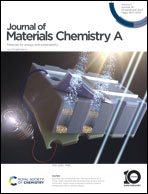Constructing a square-like copper cluster to boost C–C coupling for CO2 electroreduction to ethylene†
Abstract
The CO2 electroreduction reaction (CO2ER) to ethylene (C2H4) offers the dual promise of lowering CO2 emission while storing energy from renewable electricity, for which the development of highly efficient electrocatalysts is of great significance. Herein, by means of density functional theory (DFT) computations, we designed an electrocatalyst for CO2-to-C2H4 conversion by anchoring a Cu5 cluster supported on a MoS2 monolayer with an S monovacancy (Cu5@MoS2). Our results revealed that one Cu atom of the Cu5 cluster was embedded into the framework of the defective MoS2 monolayer, while the other four Cu atoms form a square-like island over the substrate surface. Interestingly, the C–C coupling between two *CO species can easily occur on the unique square-like active site with a low kinetic barrier of 0.56 eV to form the key *C2O2 intermediate, which can then be hydrogenated to the C2H4 product with a very low limiting potential (−0.32 eV). Significantly, alkaline conditions (pH = 13) are beneficial to further promote C2H4 synthesis. Our work may offer a new avenue to precisely modulate the structures of Cu clusters for converting CO2 into high-value target products.



 Please wait while we load your content...
Please wait while we load your content...